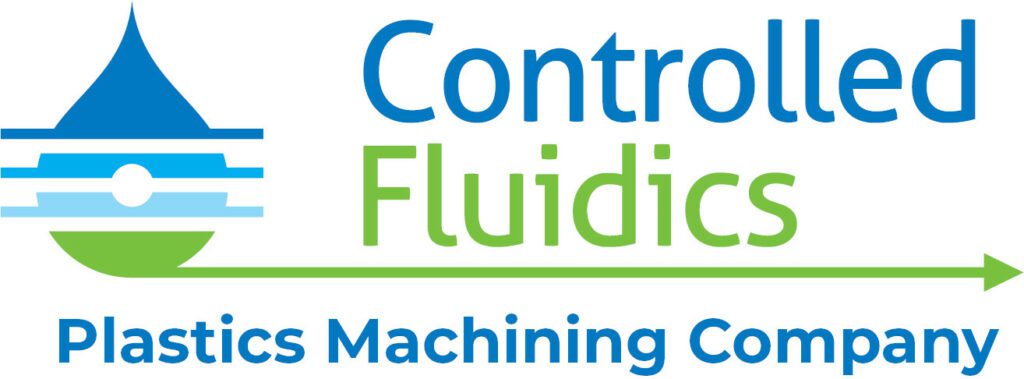
Clear & Fast Plastic Polishing
Plastic has significant advantages over other materials for optical finishing. Plastics weigh less, are durable and heat-resistant, and can take a polish just as brilliantly as traditional materials (e.g. glass) do.
Expert Guidance & Attention to Detail
While no single plastic polishing technique fits every application, we know which polishing technique will work best for your part and meet necessary requirements.

Our Plastic Polishing Methods
We know that polishing, especially on amorphous plastics, increases surface stress on plastic products.
Surface stress management is a critically important part of the plastic polishing process. Our polishing processes mitigate polishing-induced surface stress, providing high-quality plastic components that meet customer requirements. Plastic polishing methods used at Controlled Fluidics are:
Buffing
As a traditional polishing method. buffing works on all types of plastics to smooth plastic products' surfaces. This method uses a cotton cloth to abrade the surface with thousands of multi-directional scratches that clear the first layer. Eventually, the product has a brilliant sheen. We recommend this approach for large flat pieces with limited holes and projections.
Vapor Polishing
This method uses vaporized solvents or chemicals with specialized equipment to smooth and create glossy surfaces. The operator exposes the plastic's surface to those agents that then work to soften its surface and create flow for irregularities to dissipate. We typically reserve this plastic polish method for clear thermoplastics only, such as polycarbonate, ULTEM®, polysulfone, and acrylic. Unlike other polishing methods, it can polish internal features, such as threads and bores as the operator can more tightly control the materials used. We do not recommend this method for semi-crystalline materials.
Optical Machining & Polishing
Optical machining encompasses 3 different polishing techniques that give optical-grade clarity to transparent/translucent materials: mechanical, chemical, and ultrasonic. Often these require special tooling and equipment for true optical results. As optical has strict QA standards, manufacturers measure finishes for form and roughness before shipping to ensure quality. This method produces the finest finish on most plastics (100 angstroms roughness is typical).
Best Practice
The best mix of functionality and price is to polish the large faces where components mount and leave the edges as machined. The clear faces provide good sealing for the valves and visualization of the channels. The edges are left translucent as they are typically a non-working surface.
Manufacturing plastic parts from clear material is common for manifolds and machined components as it allows for easier internal process monitoring. Many amorphous materials in their raw state are clear, however, after machining they become translucent to opaque. This depends mostly on tool wear and cutting efficiency.
To return the machined part to clear, operators usually need a secondary polishing operation. Designers find that specifying the proper clarity to match the application can be a challenge.
Controlled Fluidics has defined The 4 Clarity Grades to aid this design effort.
-
GRADE 1
Standard machined plastic finish and appropriate for non-visual applications.
-
GRADE 2
Allows for activities like visual fluid flow and bubble detection. This is the most cost-efficient method with limited quantitative measurements for quality.
-
GRADE 3
This finish is appropriate for imaging through the manifold or plastic part for detection sensors. This clarity is specified in a localized area and typically not used for entire parts.
-
GRADE 4
This finish is a true optical finish specified in both surface finish and surface form. This level is appropriate for lenses but usually not used in manifold applications.
Best Plastic Materials for Polishing
Our plastic polishing process can transform some common plastics materials into extremely optically clear building blocks for projects needing the utmost transparency. When selecting materials for projects that will require polishing, use the list below to narrow your options. Any of these materials will be excellent options for polishing projects.
Click on the titles to read more about each material.
Polycarbonate
Known for clarity and toughness, polycarbonate is an extremely popular material used in medical equipment and countless other applications.
ULTEM
ULTEM is ideal for diagnostics, medical devices, transportation, electronics, and other applications that need these properties.
Polysulfone
Polysulfone is a stable plastic that resists creep, steam, and chemicals. It's a popular material for plastic parts in the aerospace, automotive, medical, and life sciences industries.
Radel
Popular for medical devices, electronic assembles, and research components, Radel is impact-resistant, hydrolysis-resistant, thermal-resistant, and combustion-resistant. It can also handle unlimited steam sterilizations.
Polyethersulfone (PES)
Radel A/PES is an amorphous thermoplastic. It boasts a high resistance to heat, combustion, and chemicals. This lightweight, dimensionally stable material is popular for pumps, valves, medical devices, and other applications.
Other Finishes
Polishing is not the only way that a manifold or component becomes complete. For other materials that cannot be polished, there are other methods to use.
Quick Note About Allowable Debris
Something we must mention about polished components is the potential cosmetic blemishes post production. This can cause some concerns about debris in the material and any loss of function when it comes to components, especially those made from acrylic.
According to the ASTM standard D4802-16, there is an allowable level of particulate debris in acrylic sheets. This standard states that any amount of particles under 0.8 mm (0.031 in) is acceptable provided they do not affect the serviceability of the sheet. Particles between 3.2 mm (0.125 in) and 0.8 mm are allowed given no more than one particle of this size is found in 0.4 m2 (4.3 ft2) of the sheet. We only purchase acrylic sheets that conform to this standard. We also hold our products to this standard, including parts in other clear materials.
While visible debris can seem inconvenient, it usually does not have an impact on functionality including those directly above a channel. For those applications requiring debris free material, please define the requirements during the quoting process. It is possible to cull material based on contamination levels with an additional cost.
Did you find this useful?
Then sign up for our email group! We send out monthly communications with content like this and more. Don't miss out!











